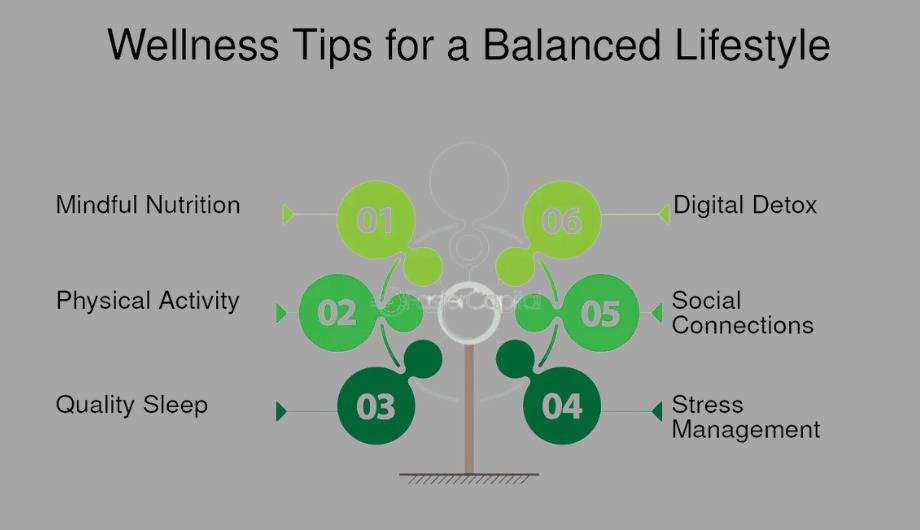Every day we are more aware of the importance of taking care of our personal well-being . As a society, we are increasingly interested in lifestyles that benefit us and in learning healthy habits in our daily lives .
This is what a personal wellness plan is all about , an action plan to improve everything that is wrong in our lives and that is taking away from our well-being. Stay to read this article and we will reveal the secrets to designing How to create a personal wellness plan tailored to you.
Wellness tips for everyday living
Maintaining wellness while juggling work and personal life can be challenging, but it’s essential for long-term health. Start with simple habits like staying hydrated, eating balanced meals, and moving your body regularly.
Below some tips which is help How to create a personal wellness plan:
Physical well-being
The first thing to evaluate in a personal wellness plan is the state of health of our body. A simple and very effective way to improve our physical health is by training, going to the gym, playing a sport or exercising. Keeping the body moving is essential to having a good mood and health: physical exercise produces endorphins , which makes us feel better.
Food well-being
Food directly influences all areas of personal well-being . It is, therefore, the main pillar. Many times due to lack of time we eat quickly and poorly, and this has a very negative effect on our personal well-being. There are numerous nutritious and easy-to-make recipes that can be prepared quickly, using ingredients that are free from fats and sugars. These two elements are often overused by the food industry and have a considerable negative impact on our health.
Look for alternative diets, healthy recipes , and if you see it necessary, visit a dietician to prepare a specialized diet for your body. It has been proven that a healthy and balanced diet improves the state of health (at all levels) and the well-being of people in a very noticeable way.

Wellbeing in the sleep cycle
Sleeping is an essential activity, but without rest it has no effect on our body; to do so, we must prepare our body for sleep . It is not enough to leave what we were doing and get into bed: sleeping requires preparation. When we sleep, our brain processes all the information impacts we have received during the day, and stores them as new information; if we do not sleep, we may have memory lapses due to a lack of this process.
But in addition to this, we must empty our minds before going to bed; to calm ourselves down for the activity of rest and regeneration that we are going to carry out. It is advisable to leave everything an hour before going to sleep, including the mobile phone. Reading is the only recommended activity before going to bed. If we do not empty our minds, our body closes its eyes but the brain does not stop working, thinking and interrelating ideas.
This leads us to dream too much and to wake up in the morning without having rested, or worse, to have insomnia . Not sleeping properly has serious negative effects: stress, anxiety, irritability, bad mood, and, over time, depression.
Psychological and emotional well-being
Clearing our mind of negative influences and destructive thoughts is a habit that we should practice every hour of the day. Control your negative thoughts, change what makes you think negatively, and stay away from people who don’t bring you well-being or who are toxic. To increase your well-being, do things you like as often as possible, try new experiences, and acquire new hobbies.
Wellbeing at work
Try to separate work from life outside the company. If your job is undermining your personal well-being , consider changing jobs and do everything possible to find one.
Social welfare
Social life is a key component of our mental well-being : friends, family and loved ones are our driving force, since we are sociable beings by nature. Look for people with similar interests, get out of the house, do outdoor activities and do teamwork, and don’t forget to make time for yourself and your best friends.
An active social life is one of the greatest restorative factors. What leads us to look for a personal well-being plan is a concern for finding complete well-being . Put this action plan into practice and live your life to the fullest, enjoying everything you have to the fullest and with inner peace.
Stay away from bad company and consult a specialist about our concerns
The most important point is to cultivate our emotional and mental health. Our brain is our engine, and when it gets overloaded we must give it a break or ask for help if necessary. Talking about our concerns with a specialist (a psychologist, for example) is an excellent way to preserve our emotional and psychological health, as if it were a periodic health check-up. On the other hand, we must leave aside toxic companies that drain our energy and negatively influence our life to strengthen our positivity.
As you can see, achieving physical and mental health is simple: put these tips into practice and start living your life fully every day
Establish routines
Routines are the basis of a healthy and satisfying life . A chaotic schedule does not benefit our fullness, on the contrary: it destabilizes our body, its schedule for hunger and ends up disturbing the sleep cycle, which can cause insomnia (a very serious problem today). A schedule always helps to think in an orderly manner: it is not only about organizing daily tasks, but about building in our mind an organized and orderly way of thinking, focused on a specific direction.
Schedules and routines put our lives into a dynamic that makes it easier to complete all our duties in less time and in a much more satisfactory way, avoiding stress.
Cultivate hobbies and have habits
Hobbies are a reflection of our personality, so exploring our hobbies is a way to get to know ourselves. Regularly pursuing our hobbies, as well as exploring new ones, is an excellent way to communicate with ourselves on a daily basis and remember who we are, as well as a link to strengthen ties with other people and forge new friendships.

Nutrition tips for a successful wellness plan
1. Eat varied and nutritious foods every day
Food is healthier and more nutritious when you include several types of food in each meal. Your daily diet should include: fruits, vegetables of different colors, legumes (beans, lentils, chickpeas), whole grains, nuts, low-fat dairy products, lean meat, fish and eggs.
2. Avoid saturated fats and fast foods
Reduce your consumption of saturated fats, which can be harmful to your health. They are found in lard, butter, red meat, baked goods, cookies and desserts. Keep in mind that fast foods such as pizza, hamburgers, French fries, empanadas and fried chicken are high in calories, high in fat and low in nutrients and fiber.
3. Eat more fruits and vegetables: 5 a day
Eat 3 fruits and 2 vegetables of different colors daily, these improve your health and nutrition.
Fruits such as mango, papaya, guava, melon, orange and peach provide vitamins A and C, necessary for the immune system and vision, and also natural fiber that is necessary for digestion.
Vegetables are rich in vitamins and some essential minerals to activate the mind, protect the heart, maintain physical performance and the nervous system. Eat green leafy vegetables (spinach, chard, broccoli) and yellow vegetables (pumpkin, carrot, zucchini); also orange, violet, white and red.
4. Watch your weight
To keep track of your weight, start by measuring your height and weight and writing down the data. Then divide it by the formula weight/height squared. The result is the body mass index (BMI) and is classified as follows (for adults between 20 and 60 years old):
- Underweight: BMI less than 18.5
- Normal weight: BMI from 18.5 to 24.9
- Overweight: BMI greater than or equal to 25
- Obesity: BMI greater than or equal to 30
5. Avoid consuming sugary drinks
Sugary drinks only provide empty calories; that is, they lack nutrients. People who regularly consume them are at risk of diseases such as obesity and diabetes. Drink water instead of soft drinks and sodas.
6. Less salt in your diet
Do not add table salt to your food. Limit the use of sauces (e.g. tomato sauce or mayonnaise) and avoid processed foods with a high sodium content such as canned foods, sausages, cold cuts and meat or chicken broth. Choose fresh foods. Consuming too much sodium can result in elevated blood pressure levels.
7. Choose whole foods
Whole foods have a higher nutritional value than refined foods. They retain their vitamin content (especially vitamin E and B complex) and minerals. Due to their high fiber content, they allow fat to be converted directly into energy, preventing it from accumulating in the tissues and arteries, preventing the appearance of cardiovascular diseases and certain types of cancer.

Frequently Asked Question
Can a personal wellness plan help with stress management?
Yes, a personal wellness plan can include specific strategies for managing stress, such as mindfulness practices, relaxation techniques, and regular exercise. This holistic approach can improve your overall stress levels.
How often should I update my wellness plan?
Regularly review your wellness plan, ideally every 3 to 6 months, to ensure it aligns with your evolving needs and goals. Adjust your plan as necessary to reflect changes in your lifestyle or health.
Final Verdict: How to create a personal wellness plan
How to create a personal wellness plan is crucial for achieving a balanced and fulfilling life. Your needs and goals may evolve over time, and that’s perfectly okay. Regularly review and adjust your plan to ensure it remains aligned with your lifestyle and aspirations. Wellness is about balance—taking care of your mind, body, and soul in small, meaningful ways every day















Leave a Reply